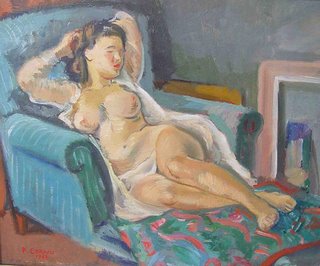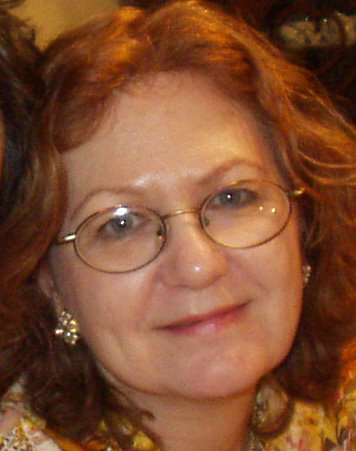Nue au Chapeau
 This weekend I watched an extremely long French movie, La Belle Noiseuse. That translates to "The Beautiful Annoyance." Michel Piccoli, one of the stars of my very favorite movie, Le Charme discret de la bourgeoisie, is Frenhofer, a once-famous artist who hasn't painted for ten years. The unbelievably gorgeous Emmanuelle Béart is Marianne, the young woman who inspires him to begin working again on his unfinished possible-masterpiece, "La Belle Noiseuse."
This weekend I watched an extremely long French movie, La Belle Noiseuse. That translates to "The Beautiful Annoyance." Michel Piccoli, one of the stars of my very favorite movie, Le Charme discret de la bourgeoisie, is Frenhofer, a once-famous artist who hasn't painted for ten years. The unbelievably gorgeous Emmanuelle Béart is Marianne, the young woman who inspires him to begin working again on his unfinished possible-masterpiece, "La Belle Noiseuse."Marianne is unwilling at first to pose, then by stages intimidated, defiant, and finally furiously angry at him. Then when he wants to quit, she won't allow it. Their battle of wills ends with him completing the painting, which does capture the truth he is seeking. She gets a glimpse of the painting and is shocked by what it reveals. Frenhofer's wife (and former muse) sneaks into his studio and views it, too. Frenhofer then walls up his masterpiece, paints another, less revealing study, and presents that to the public. All the principals keep mum about what's really happened.
Most of this film takes place in the artist's studio, with long scenes involving the artist making endless studies of his model, and no soundtrack but the scraping of the pen or charcoal on the paper. Emmanuelle Béart is wonderfully expressive as she's forced into a series of tortuous poses and made to maintain them interminably.
In my opinion, La Belle Noiseuse is itself a masterpiece. Director Jacques Rivette gets to the bottom of what art is all about. Frenhofer approaches painting with trepidation because he knows that once he gets going, people may get hurt. He has to go wherever the painting takes him, even if he risks disrupting his extremely comfortable way of life, and others'. As a writer, I can identify with that. I didn't pick up a pencil for forty years because of it. When you start writing, you don't know what's going to end up on the page.
I can identify with the model, as well. In 1968, while living in Aix-en-Provence, I posed for the painter Pierre Cornu. His regular model, Babette, was a friend of mine, and asked me to substitute for her at one point when she was taken ill. The artist was ok with the switch.
Cornu is a painter of light and color, whose work is reminiscent of Bonnard's. His oils now go for around $4,000 up to $10,000. Although Cornu painted portraits, natures mortes and landscapes, he is most famous for his nudes. He was "très attiré par les femmes dans l’éclat de leur jeunesse." He painted me allongée sur une chaise, wearing nothing but a hat. A painting session began with him manipulating my limbs like a doll's, then ordering me not to move a muscle. No conversation, no breaks. It's easy to feel restless, vulnerable, objectified.
Pierre Cornu died in 1995. He's gone, and now I'm the struggling artist. And somewhere, in a salon or a galérie--if no one's walled it up--hangs a Femme Nue au Chapeau which looks very like me.
Labels: art, La Belle Noiseuse, Pierre Cornu

